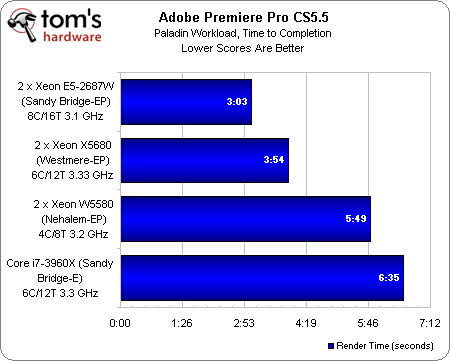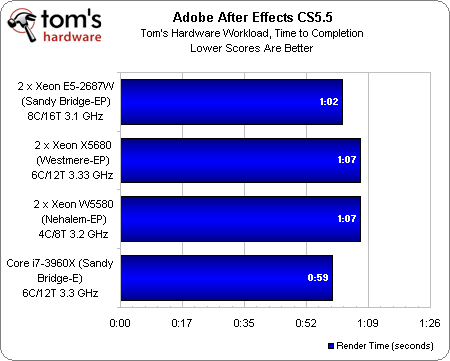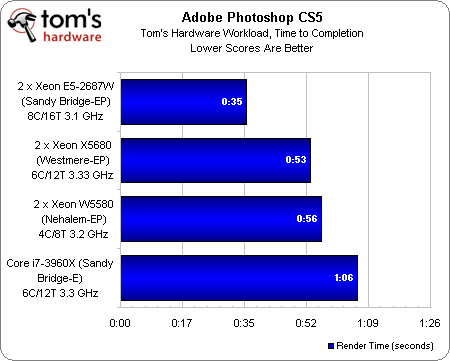Intel Xeon E5-2600: Doing Damage With Two Eight-Core CPUs
Intel's vaunted Sandy Bridge architecture has finally made its way to the company's dual- and quad-socket-capable Xeon processors. We got our hands on a pair of eight-core Xeon E5-2687W CPUs to compare against the older Xeon 5600- and 5500-series chips.
Benchmark Results: Adobe Creative Suite CS5.5
Our Premiere Pro workload comes from Adobe’s Creative Suite launch. It’s a professional-grade trailer for a new TV series, and we’ve seen it take anywhere from under a minute to over an hour to render. Generally, the difference is attributable to hardware support for the Mercury Playback Engine, enabled exclusively through Nvidia’s CUDA. So, I picked a FirePro card for all of our testing, allowing a closer look at CPU performance without GPU interference.
The results are compelling. You can use a single Core i7-3960X for this task, but it takes more than two times longer to render than a pair of Xeon E5-2687Ws. Even the Xeon 5500s get destroyed—and those were supposed to be the most significant server processors in history according to Pat Gelsinger back in 2009.
Of course, context is critical. Check out all of the processors we tested on page seven of Intel Core i7-3930K And Core i7-3820: Sandy Bridge-E, Cheaper. If you’re using a desktop card like Nvidia’s GeForce GTX 580, even a Phenom II X6 1100T can get this job finished in half the time of two pricey Xeon E5s. I’m no fan of locking out the competition, but when there’s money on the line, professionals working in CS5 simply owe it themselves to use a CUDA-enabled card.
The results in our After Effects rendering test don’t look anything like Premiere Pro. The Core i7-3960X—twelve threads with access to 32 GB of memory—fares best. The Nehalem- and Westmere-based architectures, with 16 and 24 threads, respectively, and 48 GB of memory roughly match each other. The Xeon E5s fall somewhere in between.
The scores in Photoshop get us back to the performance picture we’d expect. Though the Xeon 5600s and 5500s yield fairly similar results, they both outperform a Core i7-3960X. In turn, Intel’s new Xeon E5-2687Ws make quick work of previous-generation dual-socket platforms.
Get Tom's Hardware's best news and in-depth reviews, straight to your inbox.
Current page: Benchmark Results: Adobe Creative Suite CS5.5
Prev Page Benchmark Results: Sandra 2012 Next Page Benchmark Results: Media/Encoding-
CaedenV My brain cannot comprehend what CS5 would look like with this combined with a 1TB R4 drive, and the GTX680 version of the Quatro would look like... and I am sure my wallet cannot!Reply
Great article! I was not expecting my mind to be blown away today, and it was :) -
dalethepcman No gaming benchmarks? I know this is a high workstation / mid server build, but you know some of the boutiques will make a gaming rig out of any platform. Just out of curiosity, I would have liked to see 2x7970 or 2x580 and a few gaming benchmarks thrown in. :)Reply -
willard dalethepcmanNo gaming benchmarks? I know this is a high workstation / mid server build, but you know some of the boutiques will make a gaming rig out of any platform. Just out of curiosity, I would have liked to see 2x7970 or 2x580 and a few gaming benchmarks thrown in.I'd be really surprised to see these in gaming machines, even in the high end boutiques. That's a $2k processor they reviewed, and basically all it offers over the $1k SB-E chip (for gamers) is an extra pair of cores, which games can't make use of.Reply -
reclusiveorc I wonder how fast TempEncode would chew thru transcoding avi/wmv files to mp3/mp4Reply -
willard esreverwhy aren't AMD cpus tested too? I wouldn't mind seeing how 2x interlagos stacks up.Anandtech benched those next to the new Xeons. Went about as well as Bulldozer vs. Sandy Bridge.Reply
http://www.anandtech.com/show/5553/the-xeon-e52600-dual-sandybridge-for-servers/6 -
cangelini esreverwhy aren't AMD cpus tested too? I wouldn't mind seeing how 2x interlagos stacks up.Mentioned on the test page--I've invited them to send hardware and they haven't moved on it yet.Reply -
willard cangeliniMentioned on the test page--I've invited them to send hardware and they haven't moved on it yet.I would guess that's because Interlagos is garbage compared to the new Xeons and they know it. I don't think they're terribly eager for the front page of Tom's Hardware to show the low end Xeon's beating the best Interlagos has to offer.Reply -
Onus What, or who, was the target? Are there military applications for this weapon?Reply
Sorry, vote me down all you like, but the title was just silly.




